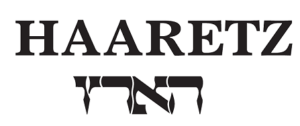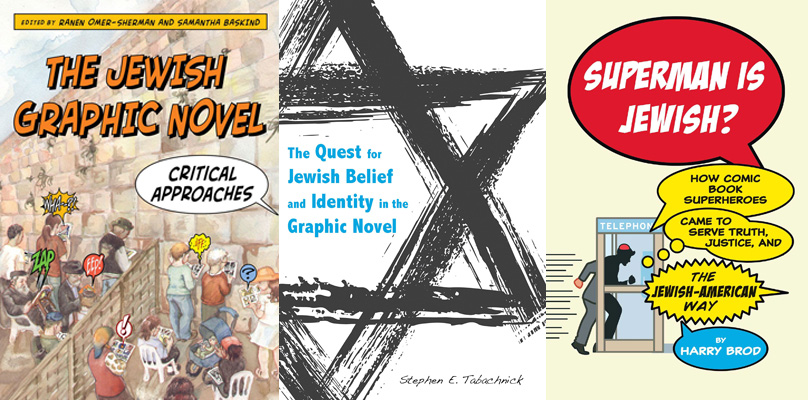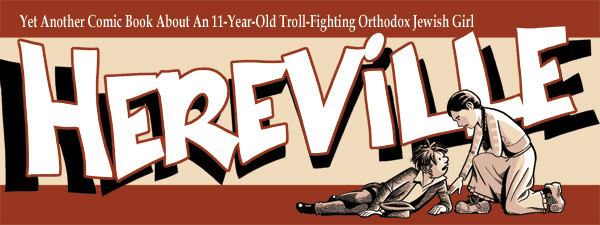A little over 7 years ago, Aaron Passman wrote an excellent article for The Jewish Exponent, in which he discussed the growing interest in the topic of Jews and the comic book industry. At the time, the book From Krakow to Krypton (by Arie Kaplan) had just been published. In the article, Passman quoted Kaplan as well as the authors of 3 other similar books (Danny Fingeroth, Paul Buhle, and Simcha Weinstein). He also characterized the subject as “something of a cottage industry,” suggesting that the books, panels,and blogs dedicated to the topic were just the tip of the iceberg. In fact, Passman was rather prophetic in that regard.
 Alas, if one were to read Nirit Anderman’s article in last week’s Haaretz (“Supermensches: Comic Books’ Secret Jewish History“), one might think that research on “Jews and comics” mysteriously ended in 2008. None of the five books that have been published after Kaplan’s are mentioned (The Jewish Graphic Novel, edited by Samantha Baskind and Ranen Omer-Sherman; Jewish Images in the Comics by Fredrik Strömberg ; Superman Is Jewish? by Harry Brod; Graphic Details, edited by Sarah Lightman; and The Quest for Jewish Belief and Identity in the Graphic Novel by Stephen Tabachnick). If Anderman wanted a 2016 “hook” to introduce the article, she could have announced that the book “How Come Boys Get to Keep Their Noses?” by Tahneer Oksman (a study of Jewish women cartoonists’ autobiographical memoirs) is scheduled to be published this month. There is no mention of the travelling exhibitions which have helped to legitimize the field and to present the stories and artwork to the general public (e.g. Heroes, Freaks & Super-Rabbis; Graphic Details; Jomix). It would have been nice if the author had made reference to any of the academic courses on Jewish Graphic Novels which are now being taught (e.g. HUM113 at Union College; RELI217 at Wesleyan University; History 490Q at University of British Columbia).
Alas, if one were to read Nirit Anderman’s article in last week’s Haaretz (“Supermensches: Comic Books’ Secret Jewish History“), one might think that research on “Jews and comics” mysteriously ended in 2008. None of the five books that have been published after Kaplan’s are mentioned (The Jewish Graphic Novel, edited by Samantha Baskind and Ranen Omer-Sherman; Jewish Images in the Comics by Fredrik Strömberg ; Superman Is Jewish? by Harry Brod; Graphic Details, edited by Sarah Lightman; and The Quest for Jewish Belief and Identity in the Graphic Novel by Stephen Tabachnick). If Anderman wanted a 2016 “hook” to introduce the article, she could have announced that the book “How Come Boys Get to Keep Their Noses?” by Tahneer Oksman (a study of Jewish women cartoonists’ autobiographical memoirs) is scheduled to be published this month. There is no mention of the travelling exhibitions which have helped to legitimize the field and to present the stories and artwork to the general public (e.g. Heroes, Freaks & Super-Rabbis; Graphic Details; Jomix). It would have been nice if the author had made reference to any of the academic courses on Jewish Graphic Novels which are now being taught (e.g. HUM113 at Union College; RELI217 at Wesleyan University; History 490Q at University of British Columbia).
 Anderman discusses several Jewish-content graphic books in the article. However, many of these are several years old. It is impossible to list off every Jewish graphic novel in such a short piece, but one would hope that the most recent publications would have been included. Hereville : How Mirka Caught a Fish recently won the 2015 Sydney Taylor Award (Older Readers Category), the second such win for its author Barry Deutsch. Although Haaretz is an Israeli publication, no graphic books about Israel (e.g. Not the Israel My Parents Promised Me; Jerusalem: A Family Portrait; Exit Wounds; Jerusalem: Chronicles from the Holy City; Mike’s Place) are discussed.
Anderman discusses several Jewish-content graphic books in the article. However, many of these are several years old. It is impossible to list off every Jewish graphic novel in such a short piece, but one would hope that the most recent publications would have been included. Hereville : How Mirka Caught a Fish recently won the 2015 Sydney Taylor Award (Older Readers Category), the second such win for its author Barry Deutsch. Although Haaretz is an Israeli publication, no graphic books about Israel (e.g. Not the Israel My Parents Promised Me; Jerusalem: A Family Portrait; Exit Wounds; Jerusalem: Chronicles from the Holy City; Mike’s Place) are discussed.
Though not as troubling as the incompleteness of the research, it’s a bit off-putting that carelessness seems to have resulted in quite a few factual errors. Batman first appeared in Detective Comics #27, not in Batman #1. Iron Man is misspelled as “Ironman.” The story in which Superman captured Stalin and Hitler wasn’t published in a comic book, but in the magazine Look. MAD didn’t start out as a magazine. It was a comic book, but the publisher switched formats to avoid the restrictions of the Comics Code.
To be fair, I don’t know to what extent the shortcomings of the article may be the fault of the editor assigned to the story. However, ultimately, it is the article’s author who gets the byline and is deemed responsible for it. As someone who enjoys reading about the work of Jewish comics professionals and Jewish comic stories, I was looking forward to reading Anderman’s article after Weinstein posted on Facebook about it. I was expecting the article to be more relevant and up-to-date, but instead came away feeling disappointed. Jews have a rich and centuries-old history, but the immediate history of scholarship on comics and Judaism cannot be glossed over so hastily by any reputable news or academic source.
 *****
*****
Steven M. Bergson is a blogger at http://www.jewishcomics.blogspot.com and has reviewed several graphic books for AJL Reviews (Association of Jewish Libraries). He edited the first volume of Jewish Comix Anthology (Oakville, ON : AH Comics, 2014).
 Over at his Jewish Comics blog, S&S’s own Steve Bergson interviews Barry Deutsch on his latest installment of the Hereville series as well as the recent honor of once again winning the Sydney Taylor Award. The Hereville graphic novels feature, as quoted on the latest cover, “yet another 11-year-old time-traveling Orthodox Jewish babysitter” Mirka Hirschberg.
Over at his Jewish Comics blog, S&S’s own Steve Bergson interviews Barry Deutsch on his latest installment of the Hereville series as well as the recent honor of once again winning the Sydney Taylor Award. The Hereville graphic novels feature, as quoted on the latest cover, “yet another 11-year-old time-traveling Orthodox Jewish babysitter” Mirka Hirschberg.

 Anderman discusses several Jewish-content graphic books in the article. However, many of these are several years old. It is impossible to list off every Jewish graphic novel in such a short piece, but one would hope that the most recent publications would have been included. Hereville : How Mirka Caught a Fish recently won the 2015
Anderman discusses several Jewish-content graphic books in the article. However, many of these are several years old. It is impossible to list off every Jewish graphic novel in such a short piece, but one would hope that the most recent publications would have been included. Hereville : How Mirka Caught a Fish recently won the 2015 
